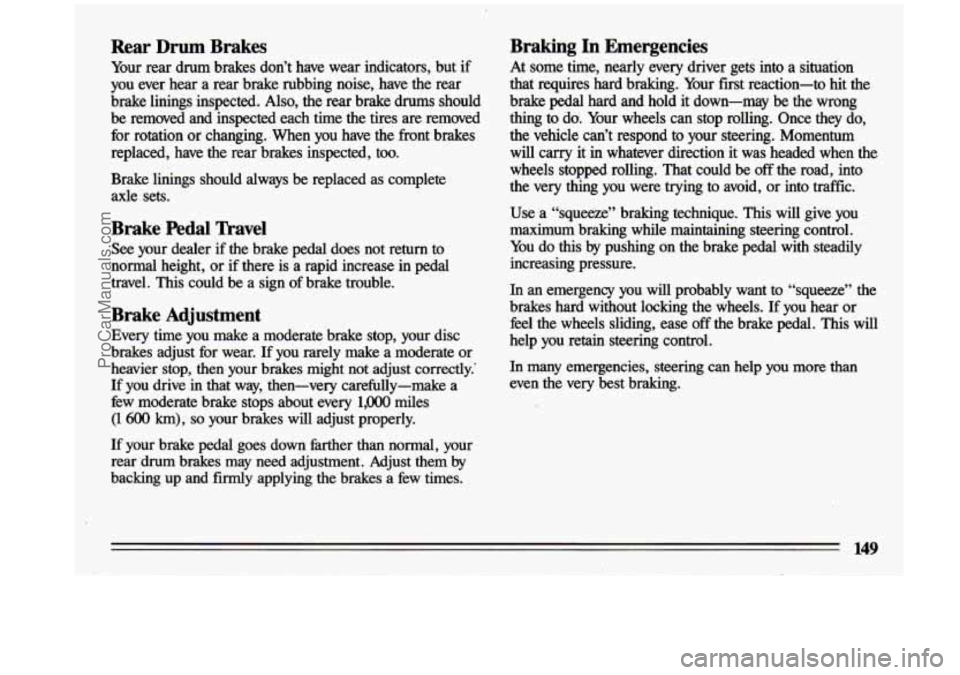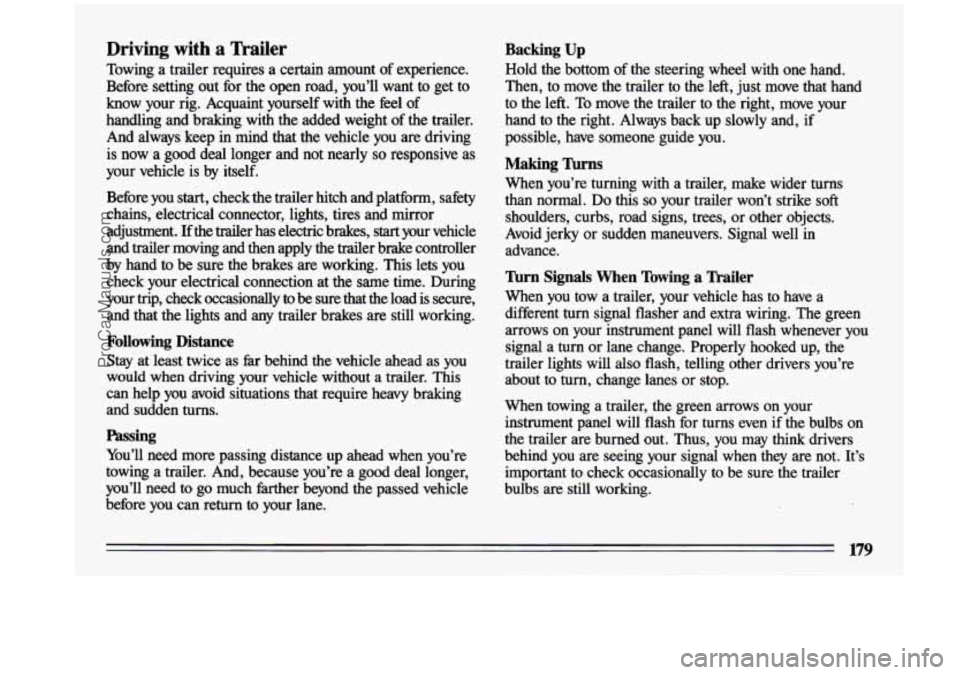1993 BUICK CENTURY steering wheel adjustment
[x] Cancel search: steering wheel adjustmentPage 151 of 324

Rear Drum Brakes
Your rear drum brakes don’t have wear indicators, but if
you ever hear a rear brake rubbing noise, have the rear
brake linings inspected.
Also, the rear brake drums should
be removed and inspected each time the tires are removed
for rotation or changing. .When you have the front brakes
replaced, have the rear brakes inspected, too.
Brake linings should always be replaced as complete
axle sets.
Braking In Emergencies
At some time, nearly every driver gets into a situation
that requires hard braking. Your first reaction-to
hit the
brake
pedal hard and hold it down-may be the wrong
thing to do. Your wheels can stop rolling. Once they
do,
the vehicle can’t respond to your steering. Momentum
will carry it
in whatever direction it was headed when the
wheels stopped rolling. That could be
off the road, into
the very thing you were trying
to avoid, or into traffic.
Use a “squeeze” braking technique. This will give you
maximum braking while maintaining steering control.
You do
this by pushing on the brake pedal with steadily
increasing pressure.
Brake Pedal Travel
See your dealer if the brake pedal does not return to
normal height, or if there is a rapid increase in
pedal
travel. This could be a sign of brake trouble.
Brake Adjustment
Every time you make a moderate brake stop, your disc
brakes adjust for wear.
If you rarely make a moderate or
heavier stop, then your brakes might not adjust correctly.’
If you drive in that way, then-very carefully-make a
few moderate brake stops about every
1,0oO miles
(1 600 km), so your brakes will adjust properly.
If your brake pedal goes down farther than normal, your rear drum brakes may need adjustment. Adjust them by
backing up and
firmly applying the brakes a few times. In an emergency you will probably want
to “squeeze”
the
brakes hard without locking the wheels.
If you hear or
feel the wheels sliding, ease off the brake pedal. This will
help you retain steering control.
In many emergencies, steering can help you more than
even the very best braking.
149
ProCarManuals.com
Page 181 of 324

Driving with a Trailer
Towing a trailer requires a certain amount of experience.
Before setting out for the open road, you’ll want to get t\
o
know your rig. Acquaint yourself with the
feel of
handling and braking with the added weight of the trailer.
And always keep in mind that the vehicle you
are driving
is now a good deal longer and not nearly
so responsive as
your vehicle is by itself.
Before you
start, check the trailer hitch and platform, safety
chains, electrical connector, lights, tires and mirror
adjustment. If the trailer has electric brakes,
start your vehicle
and trailer moving and then apply the trailer brake controller \
by hand to be sure the brakes
are working. This lets you
check your electrical connection at the same time. During
your trip, check occasionally
to be sure that the load is secure,
and that the lights and any trailer brakes are still working.
Following Distance
Stay at least twice as fit, behind the vehicle ahead as you
would when driving your vehicle without a trailer. This
can help you avoid situations that require heavy braking
and sudden turns.
Passing
You’ll need more passing distance up ahead when you’re
towing
a trailer. And, because you’re a good deal longer,
you’ll
need to go much farther beyond the passed vehicle
before you can return to your lane.
Backing Up
Hold the bottom of the steering wheel with one hand.
Then, to move the trailer to the left, just move that hand
to the left.
To move the trailer to the right, move your
hand to the right. Always back up slowly and, if
possible, have someone guide you.
Making nrns
When you’re turning with a trailer, make wider turns
than normal.
Do this so your trailer won’t strike soft
shoulders, curbs, road signs, trees, or other objects.
Avoid jerky or sudden maneuvers. Signal well in
advance.
Turn Signals When Towing a Mler
When you tow a trailer, your vehicle has to have a
different turn signal flasher and extra wiring. The green arrows on your instrument panel will flash whenever you
signal a turn or lane change. Properly hooked up, the
trailer lights will also flash, telling other drivers you’re \
about to turn, change lanes or stop.
When towing a trailer, the green arrows on your instrument panel will flash for turns even if the bulbs on
the trailer are burned out. Thus, you may think drivers
behind you are seeing your signal when they are not. It’s
important to check occasionally to be sure the trailer
bulbs are still working.
179
ProCarManuals.com
Page 309 of 324

Brake Fluid ................................ .243. 292
Electrical Equipment
..................... .75. 117. 265
Engine Coolant
................ .195. 239. 270. 272. 292
Engine Oil
........................ .227. 270. 272. 292
Sound Equipment
................................ 117
Power Steering Fluid
................ .241. 271. 273. . 292
Transaxle Fluid
.................... .236. 271. 273. 292
Windshield Washer Fluid
.................... .242. 293
AirBag(S1R)
..................................... 35
Air Cleaner
............................. .233. 271. 273
Air Conditioner
.......................... .114. 270. 272
Alcohol in Gasoline
................................ 223
Aluminum Wheels. Cleaning
........................ 262
Antenna Care
..................................... 131
Antifreeze
.......................... .239. 270. 272. 292
Ashtrays and Lighter
............................... 104
Audiosystems
.................................... 116
AM/FM Stereo Radio
............................. 118
Alcohol. Driving Under the Influence
of
............... 143
Appearance Care and Maintenance Materials
....... .258. 264
AM/FM Stereo Radio with Cassette Player
............ EO
AM/FM Stereo with Compact Disc Player ............ 123
Care
of Audio Systems ............................ 129 Radio Reception. Understanding
.............. 117
Setting the Clock
.................. .118. 121. 124
Automatic Door Locks
........................ 66
Automatic Lap-Shoulder Belt (see “Safety Belts”)
Automatic Transaxle Adding Fluid
................ .236. 271. 273. 292
Checking Fluid
........................... 236
Shifting
.................................. 77
Starting Your Engine
........................ 74
Batteries. Remote Lock Control
............... 66
Battery
.................................... 244
Jump Starting
............................. 185
Warnings
....................... .185, 186, 244
Battery Warning Light
........................ 108
Blizzard
................................... 173
Block Heater, Engine
.................... .76, 232
Blowout, Tire
............................... 205
Brake Adjustment
............................... 149
Fluid ............................... 243, 292
Master Cylinder
.......................... 243
Parking
.................................. 80
307
.
ProCarManuals.com